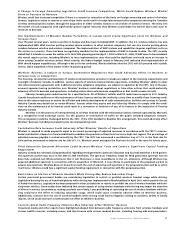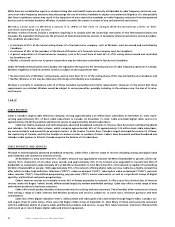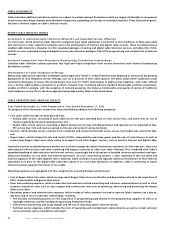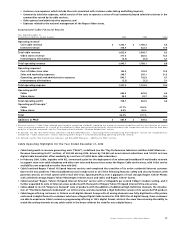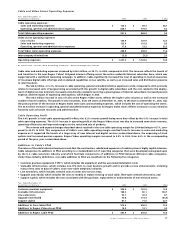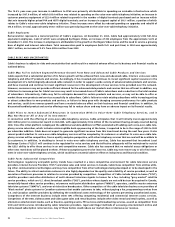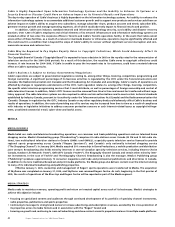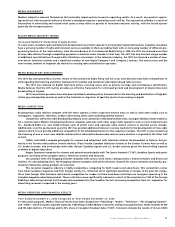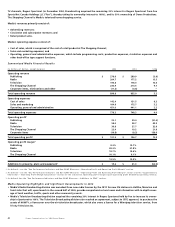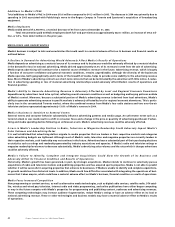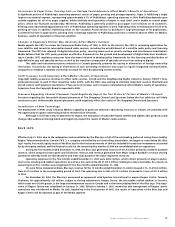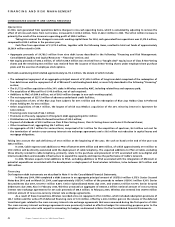Rogers 2004 Annual Report Download - page 42
Download and view the complete annual report
Please find page 42 of the 2004 Rogers annual report below. You can navigate through the pages in the report by either clicking on the pages listed below, or by using the keyword search tool below to find specific information within the annual report.
40 Rogers Communications Inc. 2004 Annual Report
Cable is Highly Dependent Upon Information Technology Systems and the Inability to Enhance its Systems or a
Security Breach or Disaster Could Have an Adverse Impact on its Financial Results and Operations
The day-to-day operation of Cable’s business is highly dependent on the information technology systems. An inability to enhance the
information technology systems to accommodate additional customer growth and to support new products and services could have an
adverse impact on Cable’s ability to acquire new subscribers, manage subscriber churn, produce accurate and timely subscriber bills,
generate revenue growth and manage operating expenses, all of which could adversely impact its financial results and position.
In addition, Cable uses industry standard network and information technology security, survivability and disaster recovery
practices. Over 1,400 of Cable’s employees and critical elements of its network infrastructure and information technology systems are
located at either of two sites: the corporate offices in Toronto and Cable’s Toronto operations facility. In the event that Cable cannot
access either of these facilities, as a result of a natural or manmade disaster or otherwise, operations may be significantly affected and
this could result in a condition that is beyond the scope of Cable’s ability to recover without significant service interruption and com-
mensurate revenue and customer loss.
Cable May be Required to Pay Higher Royalty Rates to Copyright Collectives, Which Could Adversely Affect its
Financial Position
The Copyright Board of Canada (“Copyright Board”) is expected to issue a decision in 2005 on the royalty rates for the retransmission of
television services for the 2004–2008 periods. As a result of this decision, the royalties Cable owes to copyright collectives could
increase. A rate increase for 2004–2008, if Cable is unable to pass the increased rates to its customers, could have a material adverse
effect on Cable’s operating results.
Cable’s Business is Subject to Various Governmental Regulations
Cable’s operations are subject to governmental regulations relating to, among other things, licencing, competition, programming and
foreign ownership. A significant percentage of its business activities is regulated by the CRTC under the Telecommunications Act
(Canada), the Radiocommunication Act (Canada) and the Broadcasting Act (Canada) and accordingly, Cable’s results of operations are
affected by changes in regulations and decisions of the CRTC. Such regulation relates to, among other things, licencing, competition,
the specific cable television programming services that it must distribute, as well as percentages of foreign ownership and control of
cable television licences. In addition, Cable’s CRTC licences must be renewed from time to time and cannot be transferred without regu-
latory approval. The cable television systems are also required to obtain certain authorizations and to meet certain technical standards
established by Industry Canada, pursuant to its authority under the Telecommunications Act (Canada) and the Radiocommunication Act
(Canada). Changes in regulation by the CRTC, Industry Canada or any other regulatory body could adversely affect Cable’s business and
results of operations. In addition, the costs of providing any of its services may be increased from time to time as a result of compliance
with industry or legislative initiatives to address consumer protection concerns or such Internet-related issues as copyright infringe-
ment, unsolicited commercial e-mail, cyber-crime and lawful access.
MEDIA
MEDIA BUSINESS
Media holds our radio and television broadcasting operations, our consumer and trade publishing operations and our televised home
shopping service. Media’s Broadcasting group (“Broadcasting”) comprises 43 radio stations across Canada (33 FM and 10 AM radio sta-
tions), two multicultural television stations in Ontario (OMNI.1 and OMNI.2), a specialty sports television service licenced to provide
regional sports programming across Canada (“Rogers Sportsnet”), and Canada’s only nationally televised shopping service
(“The Shopping Channel”). In January 2004, Media acquired 50% ownership in Dome Productions, a mobile production and distribution
joint venture. Broadcasting also holds minority interests in several Canadian specialty television services, including Viewers Choice
Canada, Outdoor Life Network (“OLN”), G4TechTV Canada (“TechTV”), The Biography Channel Canada and certain other minority inter-
est investments. In the case of TechTV and The Biography Channel, Broadcasting is also the manager. Media’s Publishing group
(“Publishing”) produces approximately 70 consumer magazines and trade and professional publications and directories in Canada.
In addition to its more traditional broadcast and print media platforms, the Media group also delivers content over the Internet relating
to many of its individual broadcasting and publishing properties.
Effective January 1, 2005, ownership and management of Rogers’ sports operations were transferred to Media. The acquisition
of SkyDome was completed on January 31, 2005, and SkyDome was renamed Rogers Centre. As such, beginning in the first quarter of
2005, the results of operations of the Blue Jays and Rogers Centre will be reported as part of the Media segment.
MEDIA STRATEGY
Media seeks to maximize revenues, operating profit and return on invested capital across each of its businesses. Media’s strategies to
achieve this objective include:
• Focusing on specialized content and audiences through continued development of its portfolio of specialty channel investments,
radio properties, publications and sports properties;
• Continuing to leverage its strong brand names to increase advertising and subscription revenues, assisted by the cross-promotion of
its properties across its media formats and in association with the “Rogers” brand; and
• Focusing on growth and continuing to cross-sell advertising and share content across its properties and over its multiple media platforms.



